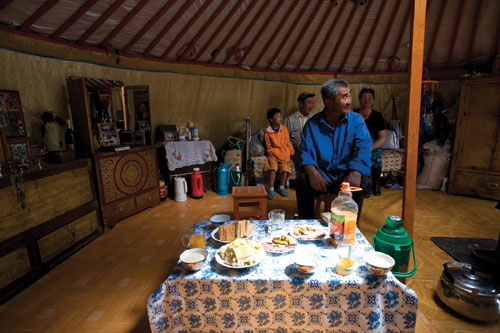Evolution of a Photo Shoot

Many of my on-location pictures are the result of a photo shoot, or photo session, that lasted at least several minutes. Only in a few rare cases do I have a one-shot photo session that happens in the blink of an eye. Understanding the importance of the photo-shoot process, and the need to work toward the exact shot you want—to set a goal—helps you get that perfect photograph.
Here are two examples from my countless photo sessions around the planet, one from an adventure to Mongolia, and one from a photo workshop I led in Kenya.
Meanderings in Mongolia
I took the opening image for this article in Mongolia where I photographed the nomad in his ger (tent-like hut) on my first day there. It’s one of my favorite nomad pictures from the adventure and it was the last shot in the evolution of a photo shoot. Unlike the following pictures from that shoot, it’s a flash picture (I bounced the light off the ceiling of the ger for soft and even lighting), because I didn’t like the high-contrast range created by the light coming through an opening in the ger’s ceiling and through the open door. Read on to see how the session began.
Here’s my first shot. My friend, Jack, and I were welcomed into the ger by the man’s family and then invited to drink fermented camel’s milk (a local custom to which you can’t say “no”). I saw a potential picture but the light coming through the opening in the ger’s ceiling caused the table to be way overexposed…but I took my test shot anyway.

I never like to overstay my welcome because it can make the subject feel uncomfortable. So, rather than start right away photographing the man, I asked our guide to move into position for a test shot. I liked the composition, especially with the clock in the picture, but I could see that the contrast range was still too great.

Almost happy with my picture, I asked our host to move into position, and he gladly accommodated my request. I played around with exposures but I couldn’t get the man and the table evenly exposed, so I knew I needed to use a flash for even illumination.

The “keeper” you see at the beginning of this column is the result of this photo session (which lasted about 15 minutes, as you can tell from the clock). You may notice that the man is now wearing traditional nomad clothes and boots—changing his clothes was his idea. He thoroughly enjoyed the photo session, according to our guide, who also acted as our translator.
In case you’re wondering what a ger looks like from the outside, here you go. And if you were wondering what fermented camel’s milk tastes (and smells) like, try this: Take a cup of milk, leave it in the hot sun for two days, and then force yourself to drink it with a smile!

Let’s travel to Kenya
This is the picture I envisioned when I saw this young girl in a Massai village in Kenya. When I see a subject I want to photograph, that envisioning process helps me get the shot. I ask myself, “If I had room on my memory card for only one shot, what would it be?” In this situation, I wanted to picture the girl against a black background, which was easily created by posing her in front of the doorway to her hut.

But she and I were strangers and spoke difference languages. I couldn’t simply walk up to her and ask if I could take her picture. That would have been very awkward, especially because I wanted to work close and get a head-and-shoulder shot. So, working with my guide, through whom I asked the girl about her daily life, I started shooting from a distance—pictures that I knew would be outtakes. I showed the girl her pictures, thereby developing a relationship with her.
As I gained her confidence and she became more comfortable and relaxed, I moved in closer. I kept shooting and then showing her the pictures on my camera’s LCD monitor. She was thrilled to see the pictures just seconds after I’d taken them.
Here are two of the dozens of outtakes from that photo session. One is a full-length shot with bad lighting and a bad pose and the other shows the girl with her eyes closed— indicating that I missed the shot.


I’ll end this article with one of my photo philosophies that sums up the evolution of a photo-session process: There’s a big difference between taking a picture and making a picture. I made this picture by asking this young Massai boy to pose in the doorway of a hut (a different hut). I asked one of my friends to hold a gold reflector so that the light from the sun bounced onto my subject, who was positioned in the deep shade. The reflector illuminated the subject with a beautiful warm light and also added contrast to the photograph.

I share these images with you not only to illustrate the evolution of one of my photo sessions but also to encourage you to keep shooting, even if you think you’ve already taken a good photograph. If you keep in mind that a photo session is an evolving process, you’ll not only have a better chance of getting the shot you want, you won’t be frustrated if you don’t get your keeper with your first shot.

